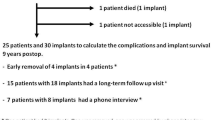Abstract
The development and the optimization of orthopaedic implants require precise studies involving geometrical, mechanical and material considerations. Moreover, the long term performance of the implant results from a compromise between the kinematic of the movement, the mechanical behavior and the bone tissue interaction. Obviously, the clinical evaluation is the best way to assess the implant performance. Nevertheless, the focus of this paper is to propose a methodology to estimate the immediate post-operative interactions between a proximal interphalangeal (PIP) joint prosthesis and the surrounding bone tissue. A finite element model of two PIP prostheses has been developed: an Ascension PIP pyrocarbon prosthesis and a new prosthesis which is currently under development (prototype prosthesis). Extreme loadings are applied to the bone models, which can be made either of young or old bone tissue: the strain state at the interface between the bone and the implant is compared to bone tissue remodeling curves. An iterative procedure is then adopted in order to improve the design of the prototype stem such that the final strain state is compatible with physiological conditions. This study shows that the strain level is always higher in the pyrocarbon implant than in the prototype prosthesis. Such high strain levels can induce bone necrosis and could explain the clinical observations of radiolucent lines around the implant resulting from a settling to a stable position.
Similar content being viewed by others
References
An K.N., Chao E.Y., Cooney W.P., Linscheid R.L.: Forces in the normal and abnormal hand. J. Orthop. Res. 3(2), 202–211 (1985)
Ash H., Unsworth A.: Proximal interphalangeal joint dimensions for the design of a surface replacement prosthesis. Proceedings of the Instituion of Mechanical Engineers, Part H. J. Eng. Med. 210(2), 95–108 (1996)
Bravo C.J., Rizzo M., Hormel K.B., Beckenbaugh R.D.: Pyrolytic carbon proximal interphalangeal joint arthroplasty: results with minimum two-year follow-up evaluation. J. Hand Surg. 32(1), 1–11 (2007)
Carter D.: Mechanical loading histories and cortical bone remodeling. Calcified Tissue Int. 36, S19–S24 (1984)
Carter, D.R., Fyhrie. D.P., Whalen, R.T.: Trabecular bone density and loading history: regulation of connective tissue biology by mechanical energy. J. Biomech. 20(8), 785–787, 789–794 (1987)
Doblaré M., García J.M.: Application of an anisotropic bone-remodelling model based on a damage-repair theory to the analysis of the proximal femur before and after total hip replacement. J. Biomech. 34(9), 1157–1170 (2001)
Doré R., Pailhes J., Fischer X., Nadeau J.P.: Identification of design variables and criterion variables towards the integration of user requirements into preliminary design. Int. J. Prod. Dev. 4(5), 508–529 (2007)
Fyhrie D.P., Carter D.R.: A unifying principle relating stress to trabecular bone morphology. J. Orthop. Res. 4(3), 304–317 (1986)
Herren D.B., Schindele S., Goldhahn J., Simmen B.R.: Problematic bone fixation with pyrocarbon implants in proximal interphalangeal joint replacement: short-term results. J. Hand Surg. J. Br. Soc. Surg. Hand 31(6), 643–651 (2006)
Hobatho, M., Rho, J., Ashman, R.: Atlas of mechanical properties of human cortical and cancellous bone. In: Van der Perre, G., Lowet, G., Borgwardt, A. (eds.) In Vivo Assessment of Bone Quality by Vibration and Wave Propagation Techniques. Part II, pp. 7–38. ACCO, Leuven (1992)
Huachou Z., Kitazawa A., Kushida Z., Nagano A.: Longitudinal study of age- and menepause-related metacarpal index changes in Japanese adult females. J. Clin. Densitom. 4(1), 43–49 (2001)
Huiskes R., Weinans H.H.J.G., Dalstra M., Fudala B., Sloof T.: Adaptative bone-remodeling theory applied to prosthetic-design analysis. J. Biomech. 20(11/12), 1135–1150 (1987)
Kalichman L., Malkin I., Seibel M.J., Kobyliansky E., Livshits G.: Age-related changes and secular trends in hand bone size. HOMO J. Comp. Hum. Biol. 59(4), 301–315 (2008)
Kanai S., Verlinden J.: Advanced prototyping for human- centered design for information appliances. Int. J. Interactive Des. Manuf. 3(3), 131–134 (2009)
Lawrence T., Trail I.A., Noble J.: Morphological measurements of the proximal interphalangeal joint. J. Hand Surg. Br. Eur. 29(3), 244–249 (2004)
Lille, R., Schiele, P., Fredenucci, J., Gueffier, X.: Prothèses ipp en pyrocarbone. résultats à moyen terme d’une série homogène de 24 cas. In: médical, S. (ed.) Arthropathies des métacarpo-phalangiennes et inter-phalangiennes de la main, actualités thérapeutiques, 2èmes rencontres de l’IMM. pp. 143–150 (2008)
Maalouf G., Wehbe J., Farah G., Sawan D., Tannous Z., Nehme A., Chidiac R.-M., Gannage Yared M.-H., Jalkh S.: Phalangeal osteosonogrammetry age-related changes and assessment of a lebanese reference population. Bone 40(6), 1650–1654 (2007)
Mathiowetz V., Kashman N., Volland G., Weber K., Dowe M., Rogers S.: Grip and pinch strength: normative data for adults. Arch. Phys. Med. Rehabil. 66(2), 69–74 (1985)
McNamara L.M., Prendergast P.J.: Bone remodelling algorithms incorporating both strain and microdamage stimuli. J. Biomech. 40(6), 1381–1391 (2007)
Passuti, N.: Ostéoconduction et ostéo-induction à la surface des prothèses. In: Conférences d’enseignement de la SOFCOT, pp. 35–50 (1995)
Rubin P., Leyvraz P., Rakotomanana L.: Intérêt de la modélisation numérique dans l’évaluation pré-clinique d’une prothèse fémorale de la hanche. Maîtrise Orthopédique 93, 22–27 (2000)
Schulter-Ellis F., Lazar G.: Internal morphology oh human phalanges. J. Hand Surg. 9(4), 490–495 (1984)
Stülpner M.A., Reddy B.D., Starke G.R., Spirakis A.: A three-dimensional finite analysis of adaptive remodelling in the proximal femur. J. Biomech. 30(10), 1063–1066 (1997)
Wolff J.: Über die bedeutung der architektur der spongiösen substanz. Zent bl. med. Wiss. VI, 223–234 (1869)
Author information
Authors and Affiliations
Corresponding author
Rights and permissions
About this article
Cite this article
Girod, L., Berry-Kromer, V., Ben Zineb, T. et al. Evaluation of the immediate post-operative bone–implant condition of a proximal interphalangeal joint prosthesis by a comparative FEA modeling. Int J Interact Des Manuf 4, 157–167 (2010). https://doi.org/10.1007/s12008-010-0097-1
Received:
Accepted:
Published:
Issue Date:
DOI: https://doi.org/10.1007/s12008-010-0097-1




